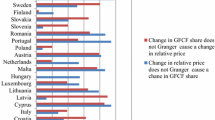Abstract
The recent emphasis on sector-specific investment strategies has led to the emergence of industry-specific calendar anomalies, notably the technology sector “summer swoon”. A standard t-test implies that these price movements provide arbitrage opportunities. However, this test fails to account for the many tests that may have preceded the swoon’s discovery. We propose the use of the Bonferroni correction to account for this unreported testing. Its application reverses the conclusions about the summer swoon and finds no evidence of calendar-based price patterns in any other sector. We also use the Bonferroni correction to revisit previously documented, market-wide, anomalies. Conclusions about the most widely cited anomalies (e.g., the January effect) are unchanged, but evidence for some other “anomalies” is substantially weakened. Our results emphasize that in evaluating a proposed anomaly, sectoral in nature or otherwise, it is crucial to account for the hypotheses that were likely to have been tested but not reported.
Similar content being viewed by others
References
Ahmed, S.W., “Issues Arising in the Application of Bonferroni Procedures in Federal Surveys.” American Statistical Association Proceedings Survey Research Methods Section 344-349, (1991).
Ariel, R.A., “A Monthly Effect in Stock Returns.” Journal of Financial Economics 18, 161-174, (1987).
Black, F., Estimating Expected Returns, New York: Goldman Sachs, 1992.
Black, “Noise.” Journal of Finance 41, 529-543, (1986).
Dimson, E. and Marsh P., “Murphy's Law and Market Anomalies.” The Journal of Portfolio Management 25, 53-69, (1999).
Fama, E.F, “Market Ef®ciency, Long-term Returns, and Behavioral Finance.” Journal of Financial Economics 49, 283-306, (1998).
French, K., “Stock Returns and the Weekend Effect.” Journal of Financial Economics 8, 55-69, (1980).
Keim, D.B., “Size-related Anomalies and Stock Return Seasonality: Further Empirical Evidence.” Journal of Financial Economics 12, 13-32, (1983).
Lo, AW. and A.C. McKinley, “Data-Snooping Biases in Tests of Financial Asset Pricing Models.” Review of Financial Studies 3, 431-467, (1990).
Marcus, A.J., “The Magellan Fund and Market Efficiency.” The Journal of Portfolio Management 17, 85-88, (1990).
Miller, R.G. Jr, Simultaneous Statistical Inference, New York: Springer-Verlag, 1981.
Richardson, M., “Temporary Components of Stock Prices: A Skeptic's View.” Journal of Business and Economic Statistics 11, 199-207, (1993).
Shaffer, J.P., “Multiple Hypothesis Testing.” Annual Review of Psychology 46, 561-584, (1995).
Sullivan, R., A. Timmermann, and H. White, “Dangers of Data-Driven Inference: The Case of Calendar Effects in Stock Returns.” University of California. San Diego Department of Economics Discussion Paper 98-16, (1998).
Sullivan, R., A. Timmermann, and H. White, “Data-Snooping, Technical Trading Rule Performance, and the Bootstrap.” Journal of Finance 54, 1647-1691, (1999).
Thaler, R.H., “Calendar Effects in the Stock Market” in Richard H. Thaler, The Winner's Curse, Princeton: Princeton University Press, (1992).
Wang, K., Y. Li, and J. Erickson, “A New Look at the Monday Effect.” Journal of Finance 52, 2171-2186, (1997).
White, H., “A Reality Check for Data Snooping.” Working paper, 1997.
Author information
Authors and Affiliations
Rights and permissions
About this article
Cite this article
Greenstone, M., Oyer, P. Are There Sectoral Anomalies Too? The Pitfalls of Unreported Multiple Hypothesis Testing and a Simple Solution. Review of Quantitative Finance and Accounting 15, 37–55 (2000). https://doi.org/10.1023/A:1008313703909
Issue Date:
DOI: https://doi.org/10.1023/A:1008313703909




